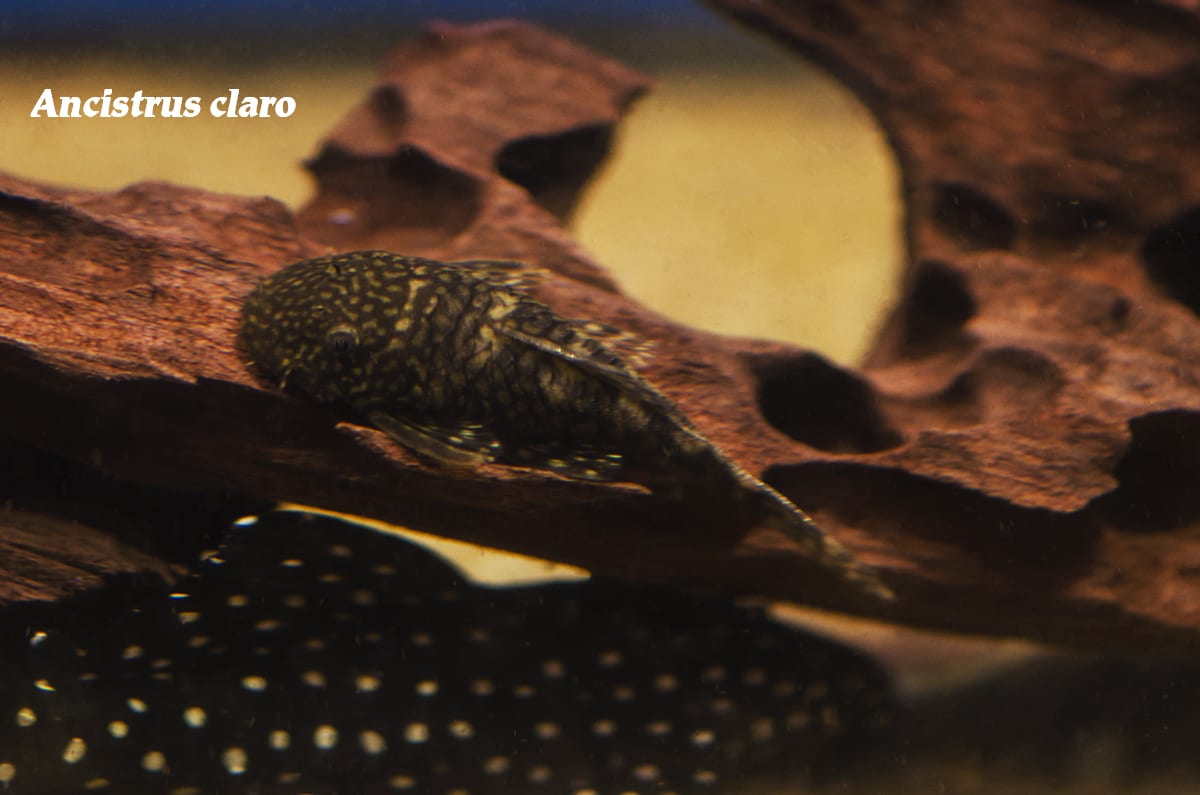The Rising Yuletide
The Rising Yuletide
‘Tis the season to be jolly, and as you deck your halls, you may notice your tanks need a little extra adornment. Now, before you go dunking strung lights and mistletoe, allow us to suggest another approach. Fish can act as decoration themselves–and your dedication is certain to impress your party guests! Our halls full of tanks containing countless glittering and festive species, we’ve put together the perfect red, green, and gold collection. Behold!: Anostomus anostomus, Brochis splendens, and Ancistrus claro.
Scientific NameAnostomus anostomus
Common NameRed-striped Headstander
Temperature / pH68 to 82°F / 5.5 to 7.5 pH
Native LocationAmazon and Orinoco
Preferred DietOmnivorous
Red as holly berries, St. Nick’s frock, and the apples of the paradise tree, A. anostomus are so excited for the holidays, they’ve been doing headstands. Oh wait, they do that all the time. More commonly known as “Red-striped Headstanders”, these oddballs are widespread through the Amazon and Orinoco river systems in South America. Nose-down, they thrive in rocky shores with strong current where they graze algae and invertebrates off the substrate. In captivity, they do best in biotope tank setups with sandy substrate, piles of smooth rocks, driftwood tangles, good flow, high oxygenation, and bright light to encourage algal growth. Having some furnishings poke above the waterline is ideal, and it is important to have a tight-fitting tank lid to prevent these leaping lords from ending up on the floor. Reaching up to 7 inches in length, these headstanders are narrow with pointed heads, silvery bodies with dark striping, and exhibit beautiful red fins. In nature, these fish swim in large shoals, however, in captivity they tend to be slightly aggressive toward conspecifics. In large tanks, they should be kept in groups of 6 or more, otherwise, they are best kept singly in community tanks of medium-sized peaceful species. As omnivorous grazers, “Red-striped Headstanders” should be fed small live and frozen foods, alongside a heavy vegetal component. Optimal water conditions include temperatures between 68 and 82°F, pH of 5.5 to 7.5, and hardness of 18-322 ppm.
Scientific NameBrochis splendens
Common NameEmerald Green Cory
Temperature / pH68 to 82°F / 5.0 to 8.0 pH
Native LocationAmazon basin
Preferred DietOmnivorous/sinking foods
Glittering and green as the freshest Christmas tree (but much longer-lasting) is Brochis splendens. Species epithet translating to “shining, gleaming, glistening, bright, brilliant”, they are certainly jewels amongst their kin. More commonly known as the “Emerald Green Corydoras”, this bottom-dweller hails from the Amazon River basin, where they tend to form small aggregations in small tributaries and still bodies of water. They do best in tanks with fine-sandy substrate and assorted furnishings from rock piles to pvc pipe to provide safe-spaces. Peaceful and gregarious, they should be kept in groups of 6 or more conspecifics, and they do great in any community tank without predatory or overly-aggressive species. Another foraging omnivore, these Cories do well with varied diets composed of high-quality sinking dried foods, and regular offerings of live or frozen fare like bloodworm. Tank waters should be kept with temperatures ranging from 68 to 82°F, pH between 5.0 and 8.0, and hardness between 36 to 268 ppm.
Scientific NameAncistrus claro
Common NameGold Marble Bushynose
Temperature / pH73 to 82°F / 6.0 to 7.5 pH
Native LocationRio Claro
Preferred DietFresh vegetal matter
Golden as the Star of Bethlehem, any wise man would and add Ancistrus claroto their tank. Also known as “Gold Marble Bushynose Pleco” or “LDA 008”, these catfish are found in the Rio Claro of central Brazil. Inhabiting flowing streams with boulders and bedrock, these shining stars do best in biotope tanks with sandy substrate and variable-sized water-worn rocks, driftwood branches, plenty of nooks and crannies to hide in, and slight current. Special amongst catfish because of their diurnal activity, they are peaceful and do great as singles living in well-chosen community tanks. Reaching nearly 3 inches in length, these plecos have bushy-nosed sucker mouths, flattened bodies, and gold and brown marbled patterning. Substrate feeding on invertebrates and vegetal matter in the wild, they enjoy feeding on high-quality sinking foods, live and frozen foods, meaty hunks like prawn, some fresh fruit, and prepared gelatin-bound foods are relished with joy. Tank waters should be maintained with temperatures between 73 and 82°F, pH of 6.0 to 7.5, and hardness of 36 to 268 ppm.
Here at The Wet Spot, Santa’s elves are working hard to spread holiday cheer the only way we know how…through fish! Looking to ‘Spruce’ up your tank? Give us a jingle today!


